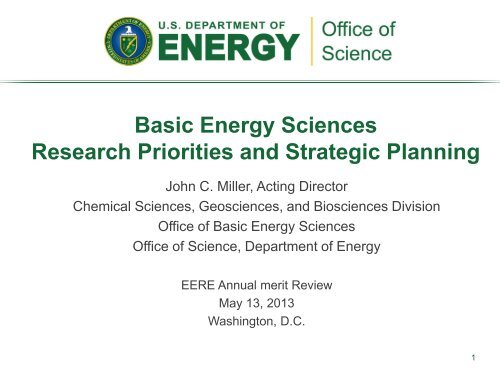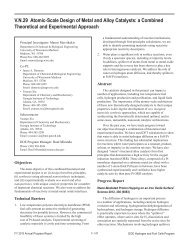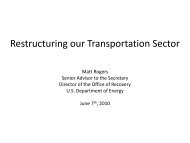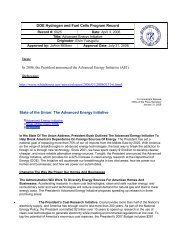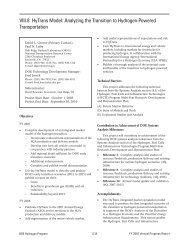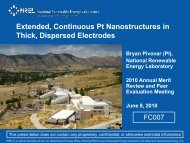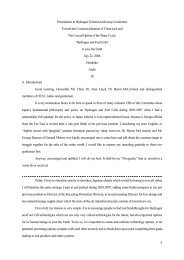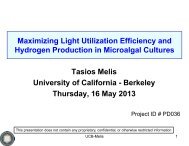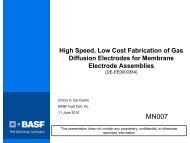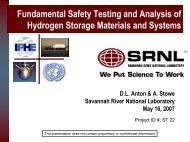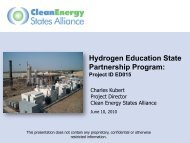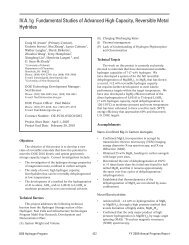DOE Basic Energy Sciences Program Overview - U.S. Department of ...
DOE Basic Energy Sciences Program Overview - U.S. Department of ...
DOE Basic Energy Sciences Program Overview - U.S. Department of ...
Create successful ePaper yourself
Turn your PDF publications into a flip-book with our unique Google optimized e-Paper software.
<strong>Basic</strong> <strong>Energy</strong> <strong>Sciences</strong><br />
Research Priorities and Strategic Planning<br />
John C. Miller, Acting Director<br />
Chemical <strong>Sciences</strong>, Geosciences, and Biosciences Division<br />
Office <strong>of</strong> <strong>Basic</strong> <strong>Energy</strong> <strong>Sciences</strong><br />
Office <strong>of</strong> Science, <strong>Department</strong> <strong>of</strong> <strong>Energy</strong><br />
EERE Annual merit Review<br />
May 13, 2013<br />
Washington, D.C.<br />
1
<strong>Basic</strong> <strong>Energy</strong> <strong>Sciences</strong><br />
<strong>Overview</strong><br />
2
Secretary<br />
Ernest Moniz<br />
(nominated)<br />
Deputy Secretary<br />
Daniel B. Poneman<br />
Advanced Research Projects<br />
Agency – <strong>Energy</strong><br />
Eric Rohlfing (Acting Dep. Dir.)<br />
Under Secretary for Nuclear<br />
Security/Administrator for National<br />
Nuclear Security Administration<br />
Vacant<br />
Under Secretary<br />
for Science<br />
Vacant<br />
Under Secretary<br />
Vacant<br />
Defense Nuclear<br />
Nonproliferation<br />
Defense <strong>Program</strong>s<br />
Naval Reactors<br />
Counter-terrorism<br />
Defense Nuclear<br />
Security<br />
Emergency<br />
Operations<br />
<strong>Basic</strong> <strong>Energy</strong> <strong>Sciences</strong><br />
Harriet Kung<br />
Advanced Scientific<br />
Computing Research<br />
Barbara Helland (acting)<br />
Biological & Environ.<br />
Research<br />
Sharlene Weatherwax<br />
Office <strong>of</strong> Science<br />
Patricia Dehmer<br />
Acting Director<br />
High <strong>Energy</strong> Physics<br />
James Siegrist<br />
Nuclear Physics<br />
Tim Hallman<br />
Fusion <strong>Energy</strong> <strong>Sciences</strong><br />
Ed Synakowski<br />
<strong>Energy</strong> Efficiency &<br />
Renewable <strong>Energy</strong><br />
David Danielson<br />
Fossil <strong>Energy</strong><br />
Christopher Smith<br />
(A)<br />
Nuclear <strong>Energy</strong><br />
Peter Lyons<br />
Electricity Delivery<br />
& <strong>Energy</strong> Reliability<br />
Pat H<strong>of</strong>fman<br />
Environmental<br />
Management<br />
Legacy<br />
Management<br />
SBIR/STTR<br />
Manny Oliver<br />
Workforce Develop. for<br />
Teachers & Scientists<br />
Patricia Dehmer (A)<br />
3
<strong>Basic</strong> <strong>Energy</strong> <strong>Sciences</strong> Mission<br />
• Fundamental research to understand, predict, and ultimately<br />
control matter and energy at the electronic, atomic, and<br />
molecular levels<br />
• Provide the foundations for new energy technologies to support<br />
<strong>DOE</strong>’s missions in energy, environment, and national security<br />
• Plan, construct, and operate world-leading scientific user facilities<br />
for the Nation<br />
5
BES Research ― Science for Discovery & National Needs<br />
Three Major Types <strong>of</strong> Funding Modality<br />
increasing progression <strong>of</strong> scientific scope and level <strong>of</strong> effort<br />
• Core Research<br />
Single-investigator, small groups, and targeted larger programs<br />
‣ Enable seminal advances in the core disciplines <strong>of</strong> the basic energy sciences—materials sciences<br />
and engineering, chemistry, and aspects <strong>of</strong> geosciences and biosciences. Scientific discoveries at<br />
the frontiers <strong>of</strong> these disciplines establish the knowledge foundation to spur future innovations and<br />
inventions.<br />
• <strong>Energy</strong> Frontier Research Centers<br />
$2-5 million-per-year research centers; multi-investigator and multi-disciplinary<br />
‣ Harness the most basic and advanced discovery research in a concerted effort to accelerate the<br />
scientific breakthroughs needed to create advanced energy technologies. Bring together critical<br />
masses <strong>of</strong> researchers to conduct fundamental energy research in a new era <strong>of</strong> grand challenge<br />
science and use-inspired energy research.<br />
Started in FY 2009<br />
• <strong>Energy</strong> Innovation Hubs<br />
$25 million-per-year research centers focus on co-locating and integrating multi-components, multidisciplinary<br />
research with technology development to enable transformational energy applications.<br />
Started in FY 2010
<strong>Energy</strong> Frontier Research Centers Update<br />
Participants:<br />
• 46 EFRCs in 35 States + Washington D.C.<br />
• ~850 senior investigators and<br />
~2,000 students, postdoctoral fellows, and<br />
technical staff at ~115 institutions<br />
• >250 scientific advisory board members<br />
from 13 countries and >40 companies<br />
Progress to date (~3.5 years funding):<br />
• >3,400 peer-reviewed papers including<br />
>110 publications in Science and Nature<br />
http://science.energy.gov/bes/efrc/<br />
• 18 PECASE and 11 <strong>DOE</strong> Early Career Awards<br />
• >200 patent/patent applications, plus an additional<br />
>60 invention disclosures and at least 30 licenses<br />
• At least 60 companies have benefited from EFRC research<br />
• EFRC students and staff now work in: >195 university faculty and staff positions;<br />
>290 industrial positions;<br />
>115 national labs, government, and non-pr<strong>of</strong>it positions<br />
7
• The initial 46 EFRCs were funded for 5-years beginning in FY 2009: 30 EFRCs were<br />
funded annually at about $100M; 16 were fully funded by Recovery Act support<br />
• For FY 2014, funding continues at $100M plus one-time funding <strong>of</strong> $68.7M<br />
• Solicitation will request both renewal and new EFRC applications including:<br />
– Areas <strong>of</strong> energy-relevant research identified by recent BES and BESAC workshops<br />
– Research to advance the rate <strong>of</strong> materials and chemical discovery<br />
– Mesoscale science<br />
<strong>Energy</strong> Frontier Research Centers<br />
Recompetition in FY2014<br />
• Selection <strong>of</strong> awards will be based on rigorous peer review <strong>of</strong> applications <strong>of</strong> the<br />
proposed research<br />
– Renewal awards will include assessment <strong>of</strong> the progress during the first 5-year award<br />
• Renewal and new awards will maintain a balanced EFRC portfolio for grand challenge<br />
and use-inspired energy research<br />
8
Fuels from Sunlight Hub<br />
Joint Center for Artificial Photosynthesis (JCAP)<br />
Mission<br />
Develop a solar-fuels generator scalable to manufacture, from earthabundant<br />
elements, that uses only sunlight, water, and carbon dioxide in the<br />
robust production <strong>of</strong> fuels<br />
JCAP Team<br />
Carl Koval, Director (CalTech); Nate Lewis, Founding Director and Chief<br />
Scientist (CalTech); two Assistant Directors; about 150 staff<br />
Space<br />
• JCAP North at LBNL: 14,000 sq. ft. leased space<br />
• JCAP South at Caltech: 18,500 sq. ft. in renovated Jorgensen Lab<br />
Building (by Caltech & initial startup funds from <strong>DOE</strong>)<br />
Funding & Oversight<br />
• Up to $122 million over five years<br />
• External reviews in 2011, 2012; scheduled at both sites for April 2013<br />
Goals & Lasting Legacies<br />
• Produce fuel from the sun 10x more efficiently than crops<br />
• Library <strong>of</strong> fundamental knowledge<br />
• Research prototype solar-fuels generator<br />
• Develop the science and the critical expertise for a solar fuels industry<br />
Milestones<br />
2013: Establish benchmarking capabilities to compare large quantities <strong>of</strong><br />
catalysts and light absorbers under standard conditions. Progress:<br />
• Benchmarking protocols established for thin films, plan to<br />
benchmark over 40 catalytic thin films.<br />
• As <strong>of</strong> March 2013, more than 20 films evaluated<br />
2014: Design the first prototypic devices for testing components<br />
(catalysts, light harvesters, membranes, interfaces, etc.) as an<br />
integrated system<br />
Jorgensen Laboratory Building<br />
Before<br />
After<br />
9
Batteries and <strong>Energy</strong> Storage Hub<br />
Joint Center for <strong>Energy</strong> Storage Research (JCESR)<br />
Mission<br />
Science to enable next generation batteries—beyond lithium ion—and energy<br />
storage for the grid and for transportation<br />
JCESR Team<br />
George Crabtree, Director (ANL); 5 national labs, 5 universities, 4 industry<br />
partners, and 2 individual members’ institutions<br />
Space<br />
• ANL Electrochemical Discovery Laboratory will provide lab and <strong>of</strong>fice<br />
space for use by all JCESR Institutions.<br />
• State <strong>of</strong> Illinois has provided $5M for a new JCESR building with state-<strong>of</strong>the-art<br />
laboratory and meeting space<br />
Funding & Oversight<br />
• Up to $120 million over five years<br />
• Management review (PY1), Annual external S&T reviews (PY2-5)<br />
Before<br />
Goals & Lasting Legacies<br />
• 5x <strong>Energy</strong> Density, 1/5 Cost, within 5 Years<br />
• Library <strong>of</strong> fundamental knowledge<br />
• Research prototype batteries for grid and transportation<br />
• New paradigm for battery development<br />
Initial Milestones<br />
2013-2014:<br />
• Bring suite <strong>of</strong> experimental tools to full operation.<br />
• Design new architectures <strong>of</strong> electrode/working ion combinations<br />
• Begin the development <strong>of</strong> an electrolyte database to predict the<br />
design <strong>of</strong> new electrolytes<br />
After<br />
JCESR will use nanoscience tools and theoretical<br />
approaches to enable next generation energy storage<br />
10
Strategic Planning in BES<br />
11
• Science for Discovery<br />
Complex<br />
System<br />
s<br />
BES Strategic Planning Activities<br />
• Science for National Needs<br />
• National Scientific User Facilities, the 21 st century tools <strong>of</strong> science<br />
12
Things Natural<br />
10 -2 m<br />
1 cm<br />
10 mm<br />
Head <strong>of</strong> a pin<br />
1-2 mm<br />
Things Manmade<br />
Human hair<br />
~ 60-120 µm wide<br />
0 nm diameter<br />
Dust mite<br />
200 µm<br />
Virus<br />
30-50 nm<br />
ATP synthase<br />
Ant<br />
~ 5 mm<br />
Red blood cells<br />
(~7-8 µm)<br />
Chloroplast 5 microns<br />
Lipid bilayer 5-10 nm<br />
Nanoworld<br />
Mesoworld<br />
10 -3 m<br />
10 -4 m<br />
10 -5 m<br />
10 -6 m<br />
10 -7 m<br />
10 -8 m<br />
10 -9 m<br />
1,000,000 nanometers =<br />
1 millimeter (mm)<br />
Ultraviolet Visible<br />
Infrared<br />
Microwave<br />
S<strong>of</strong>t x-ray<br />
0.1 mm<br />
100 µm<br />
0.01 mm<br />
10 µm<br />
1,000 nanometers =<br />
1 micrometer (µm)<br />
0.1 µm<br />
100 nm<br />
0.01 µm<br />
10 nm<br />
1 nanometer (nm)<br />
3-D grain structure<br />
Grain size ~ 10s <strong>of</strong> µm<br />
Magnetic domain structure<br />
Domain width ~ µm<br />
Self-assembled,<br />
Nature-inspired structure<br />
Many 10s <strong>of</strong> nm<br />
Pollen grain<br />
Red blood cells<br />
Hydration structure<br />
(~10nm domains) <strong>of</strong><br />
Proton Exchange<br />
Membrane<br />
MicroElectroMechanical<br />
(MEMS) devices<br />
10 -100 µm wide<br />
Nanotube electrode<br />
Tantalum microstructure<br />
Grain size ~ 10s <strong>of</strong> µm<br />
Self-assembled silicon<br />
coated carbon fibers<br />
Carbon nanotube<br />
~1.3 nm diameter<br />
DNA<br />
~2-1/2 nm diameter<br />
Atoms <strong>of</strong> silicon<br />
spacing 0.078 nm<br />
10 -10 m<br />
0.1 nm<br />
Quantum corral <strong>of</strong> 48 iron atoms on copper surface<br />
positioned one at a time with an STM tip<br />
Corral diameter 14 nm<br />
Carbon<br />
buckyball<br />
~1 nm<br />
Office <strong>of</strong> Science, U.S. <strong>DOE</strong><br />
04-10-2013, pmd
Why Mesoscale Science?<br />
“The great scientific advances <strong>of</strong> the last decade<br />
and more, especially at the nanoscale, are ripe for<br />
exploitation.<br />
Seizing this opportunity requires mastering the<br />
mesoscale, where classical, quantum, and<br />
nanoscale science meet.<br />
The functionality that is critical to macroscopic<br />
behavior begins to manifest itself not at the atomic<br />
or nanoscale but at the mesoscale, where defects,<br />
interfaces, and non-equilibrium structures are the<br />
norm.<br />
September 2012<br />
http://science.energy.gov/~/media/bes/pdf/<br />
reports/files/OFMS_rpt.pdf<br />
The reward for breakthroughs in our<br />
understanding at the mesoscale is the emergence<br />
<strong>of</strong> previously unrealized functionality.”<br />
14
Mesoscale Science - From Quanta to the Continuum<br />
• Mastering Defect Mesostructure and its Evolution<br />
Tracking, modeling and controlling the dynamic evolution <strong>of</strong> mesoscale defect patterns from their atomic origins to their<br />
macroscale impact is critical for extending materials lifetime, designing new generations <strong>of</strong> functional materials, and<br />
creating less expensive, more efficient advanced manufacturing.<br />
• Regulating Coupled Reactions and Pathway-dependent Chemical Processes<br />
Characterizing and controlling fluid flow and chemical reactions in mesoscale pathways are central to solving energy and<br />
environmental challenges such as carbon sequestration, groundwater contamination and cleanup, shale gas extraction,<br />
energy storage, separation membranes for fluid and gas purification, and subsurface geological processes.<br />
• Optimizing Transport and Response Properties by Design and Control <strong>of</strong> Mesoscale<br />
Structure<br />
Controlling the size and geometry <strong>of</strong> mesoscale architectures that mediate the interaction <strong>of</strong> electrons, photons and<br />
lattices allows new horizons in materials functionalities spanning thermoelectricity, light absorption and emission,<br />
spintronics, and multiferroics, building blocks for innovating next generation energy conversion and information<br />
technology.<br />
• Elucidating Non-equilibrium and Many-Body Physics <strong>of</strong> Electrons<br />
Controlling electronic correlation in artificial mesoscale architectures such as quantum dots and nanoparticle arrays adds<br />
new dimensions to exploiting functional behaviors from metal-insulator transitions to magnetism and high temperature<br />
superconductivity to produce entirely new levels <strong>of</strong> macroscopic functionality and advanced technology.<br />
• Harnessing Fluctuations, Dynamics, and Degradation for Control <strong>of</strong> Metastable<br />
Mesoscale<br />
The inherent metastability <strong>of</strong> complex behaviors in mesoscale biological and human-engineered systems appears on<br />
multiple length and time scales that can be exploited to introduce smart, real-time responses to environmental cues,<br />
mitigate materials degradation due to defect accumulation, and dramatically extend useful technology life.<br />
• Directing Assembly <strong>of</strong> Hierarchical Functional Materials<br />
Directed assembly <strong>of</strong> functional materials in hierarchical mesoscale architectures requires the ability to model, synthesize,<br />
and assemble building blocks with motifs that embed information and behavior via anisotropies in chemical make-up,<br />
shape, and bonding strength. The integration <strong>of</strong> disparate material motifs by “top-down” design and “bottom-up” assembly<br />
creates a new paradigm in materials synthesis and advanced manufacturing.<br />
Scanning electron<br />
microscope image <strong>of</strong><br />
pore coalescence in<br />
dynamically loaded<br />
Tantalum, showing<br />
defect evolution<br />
Pores in sandstone, a<br />
sedimentary rock formed by<br />
accumulation <strong>of</strong> many sizes<br />
and shapes <strong>of</strong> mineral and<br />
organic grains, may<br />
significantly influence transport<br />
properties.<br />
Spectroscopic scanning<br />
tunneling microscope image<br />
<strong>of</strong> the electronic modulation<br />
in BSCCO superconductors –<br />
a correlated electron material<br />
that exhibits self-organized<br />
meoscale structure.<br />
X-ray tomagraphy<br />
(left) and 3-D<br />
coherent imaging<br />
(right) are critical<br />
tools for mesoscale<br />
structural<br />
characterization.<br />
Self-assembly <strong>of</strong> silicon<br />
coated carbon fibers for<br />
battery electrodes as an<br />
energy efficient synthesis<br />
approach with organized<br />
instead <strong>of</strong> random<br />
mesostructure.<br />
100 nm<br />
15
Materials Genome Initiative<br />
• The Materials Genome Initiative will create a new era <strong>of</strong> materials<br />
innovation that will serve as a foundation for strengthening domestic<br />
industries… and <strong>of</strong>fers a unique opportunity for the United States to<br />
discover, develop, manufacture, and deploy advanced materials at<br />
least twice as fast as possible today, at a fraction <strong>of</strong> the cost.<br />
• Multiagency Initiative led by the Office <strong>of</strong> Science and Technology<br />
Policy<br />
• <strong>DOE</strong> role:<br />
– S<strong>of</strong>tware development, building on theory and partnering (BES)<br />
• Robust, accurate and multiscale in both size and time<br />
– Validation <strong>of</strong> s<strong>of</strong>tware and theory<br />
• User facilities and broad experimental materials science portfolio<br />
– Application specific R&D for manufacturing and to develop lightweight,<br />
high-strength alloys for automotive (EERE)<br />
• Technical emphasis includes materials for clean energy<br />
16
Science for Innovation and Clean <strong>Energy</strong><br />
Materials and Chemical Processes by Design<br />
• Research to establish design rules to launch an era <strong>of</strong><br />
predictive modeling, changing the paradigm <strong>of</strong><br />
materials discovery to rational design.<br />
Prediction: New battery materials<br />
starting from first principles theory<br />
– New s<strong>of</strong>tware tools and data standards to catalyze a fully<br />
integrated approach from material discovery to<br />
applications<br />
• Discovery <strong>of</strong> new materials has been the engine<br />
driving science frontiers and fueling technology<br />
innovations. Research would utilize the powerful suite<br />
<strong>of</strong> tools for materials synthesis, characterization, and<br />
simulation at <strong>DOE</strong>’s world-leading user facilities<br />
• Integrated teams to focus on key scientific knowledge<br />
gaps to develop new theoretical models<br />
– Long-term: realization in reusable and broadlydisseminated<br />
s<strong>of</strong>tware<br />
– Collection <strong>of</strong> validated experimental and modeling data<br />
for broader community use<br />
Test<br />
http://materialsproject.org/<br />
Validation:<br />
Materials<br />
fabrication<br />
End Use: S<strong>of</strong>tware on-line for<br />
general community use<br />
17
From <strong>Basic</strong> <strong>Energy</strong> Science to<br />
Technology<br />
18
Cross-cutting Investments and Coordination<br />
• <strong>DOE</strong> has increasingly emphasized cross-program communications<br />
and collaboration to ensure coordination <strong>of</strong> basic and applied<br />
research and effective integration <strong>of</strong> R&D results.<br />
– Technology Teams: working groups focused on specific technologies the<br />
meet to discuss R&D programs across the <strong>Department</strong><br />
– <strong>Energy</strong> Innovation Hubs: working group to coordinate programmatic<br />
oversight and promote commonality across all the Hubs<br />
– ARPA-E: ad-hoc groups to identity “white space” where others are not<br />
making investments in energy technologies but that would be appropriate<br />
for ARPA-E support<br />
– Topical items <strong>of</strong> interest: working groups established to address current<br />
issues such as critical materials<br />
19
Science-Based Engine Design<br />
An early example<br />
<strong>Basic</strong> Science<br />
BES<br />
Sustained support in 2 areas<br />
Development <strong>of</strong> predictive<br />
chemistry in model flames<br />
Computational<br />
kinetics and<br />
experiments<br />
Applied R&D<br />
BES EERE<br />
Applications <strong>of</strong> chemistry and<br />
diagnostics to engines<br />
Predictive<br />
chemical models<br />
under realistic<br />
conditions<br />
Manufacturing/<br />
Commercialization<br />
Cummins and Dodge<br />
Cummins used simulation tools and<br />
improved understanding <strong>of</strong> diesel fuel<br />
sprays to design a new diesel engine with<br />
reduced development time and cost and<br />
improved fuel efficiency.<br />
Advance laser diagnostics<br />
applied to model flames<br />
Laser-based<br />
chemical<br />
imaging<br />
Laser diagnostics<br />
<strong>of</strong> diesel fuel<br />
sprays in engine<br />
cylinders<br />
ISB 6.7 liter Cummins diesel<br />
engine first marketed in the 2007<br />
Dodge Ram pickup truck; more<br />
than 200,000 sold
<strong>Basic</strong> Science<br />
Platinum Monolayer Electro-Catalysts:<br />
Stationary and Automotive Fuel Cells<br />
Applied R&D<br />
Manufacturing/<br />
Commercialization<br />
BES<br />
Two research advances<br />
Pt core-shell nano-catalysts: high<br />
activity with ultralow Pt mass<br />
BES EERE<br />
Core-Shell Nanocatalysts<br />
Active Pt ML shell – Metal/alloy core<br />
Core tunes activity & durability <strong>of</strong> shell<br />
CRADA with Industry<br />
Scale-up synthesis: Pt-ML/Pd 9 Au 1 /C<br />
Excellent fuel Cell durability 200,000 cycles<br />
Core-shell catalyst<br />
Model and<br />
actual image <strong>of</strong><br />
a Pt Monolayer<br />
on Pd<br />
nanoparticle<br />
Pd<br />
Pt<br />
Pt<br />
Pd<br />
Standard catalyst<br />
Membrane Electrode Assembly >200K cycles<br />
Very small Pt diffusion & small Pd diffusion<br />
1.2<br />
Pt stabilized against corrosion in<br />
voltage cycling by Au clusters<br />
j / mAcm -2<br />
1<br />
0<br />
-1<br />
-2<br />
Au 0.67ML<br />
/Pt 10<br />
/C<br />
50mV/s, 0.1M HClO 4<br />
initial<br />
30,000 cycles<br />
0.0 0.4 0.8 1.2<br />
E / V RHE<br />
Science 315, 220 (2007)<br />
2nm<br />
j k<br />
/ A.mg -1 @0.9V<br />
0.9<br />
0.6<br />
0.3<br />
0.0<br />
Pt/C<br />
PtAuNi 5 /C<br />
Pt m a ss activity<br />
3000 hr Fuel<br />
Cell<br />
Durability<br />
Performance<br />
Pt/C<br />
PtAuNi 5 /C<br />
N oble metal mass activity<br />
Pt-mass<br />
weighted<br />
activity<br />
enhanced<br />
20x<br />
Commercial license signed Dec. 2011<br />
21
BES PI Participation in 2013 AMR Meeting<br />
• Relevant research in <strong>Basic</strong> <strong>Energy</strong> <strong>Sciences</strong> is found in the<br />
Catalysis <strong>Sciences</strong> and Separations and Analysis <strong>Program</strong>s<br />
• Membranes: 3 Oral, 3 Poster Presentations<br />
– Chemical functionalization<br />
– Simulation<br />
– Gas separations<br />
– Oral 4:15 Wed., Posters Thurs. PM<br />
• Catalysts: 3 Oral, 21 Poster Presentations<br />
– Mesostructures<br />
– Catalyst interactions<br />
– Simulation<br />
– Oral 4:15 Thur., Posters Thurs. PM
Thank You!<br />
23


